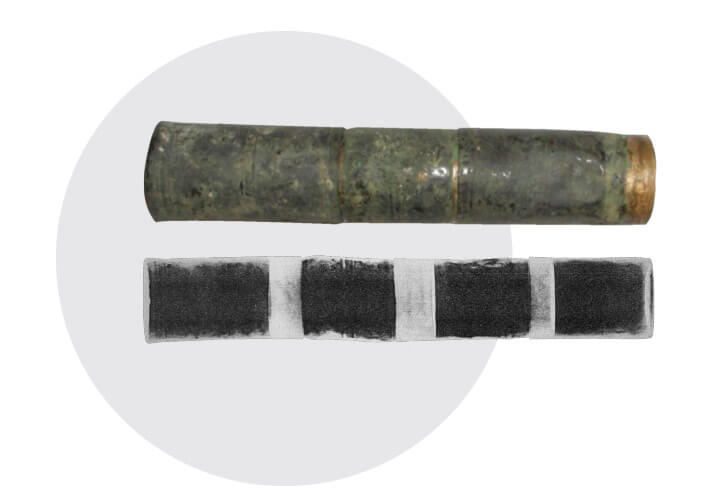When Rebecca Stacey ditched her plans to study biochemistry and opted for Archaeological Sciences instead, she was told that she was mad to enter into such a specialist field with such limited employment prospects. Fast forward 20 years and it is clear that the impulsive decision paid off. “After completing my PhD on chemical characterization of ancient food residues, I joined the British Museum when it was expanding its facilities for organic analysis,” Rebecca explains. “I am now responsible for the chromatography and mass spectrometry facilities there. My research applies the tools of analytical chemistry to interrogate the museum’s worldwide collections, seeking to understand the past use of materials and how best to ensure their preservation for the future.”

What can analysis of an ancient medicine container tell us about 1st century therapies?
A Roman multi-compartment bronze medicine container in the collection of the British Museum (BM Cat no. 1968,0626.37). The radiograph shows the individual sections, each of which contains well-preserved residues of the medicinal contents. Few medicine containers from the Roman period survive and this one is the only known example of this multi-compartment form with separate sections that stack together. This container comes from a set of Roman (1st century) surgical instruments in the British Museum collections.
Medicines typically comprise complex mixtures of organic and inorganic ingredients, a combination of active therapeutic substances with fillers and delivery substrates. Active ingredients are likely to be the most expensive (and potentially toxic) components and are therefore more likely be minor constituents. These ingredients are also more likely to be reactive substances vulnerable to loss in archaeological conditions and timescales. This is a frustration because these are key ingredients for inferring the intended past medicinal application. Interpretation of molecular data obtained from these types of sample is further complicated by the alterations that take place in archaeological materials as a result of degradation. Analysis of comparative reference materials and artificial degradation experiments are a routine part of research to characterize such material. In this case experimental simulation of ancient processing methods - the production of Punic wax from beeswax – made a crucial contribution to the interpretation.
A multi-analytical approach was adopted to ensure maximum capture of compositional information from the sub-milligram samples available from the medicine residues. After initial visual examination using optical microscopy, inorganic components were analyzed non-destructively by X-ray fluorescence and Raman spectroscopy. Analysis by gas chromatography - mass spectrometry (GC/MS) was carried out on solvent extracted and hydrolyzed sub-samples prepared both as trimethylsilyl (TMS) and methyl ester derivatives. The separate preparation methods enabled detection of wax, lipid, resin and carbohydrate constituents. The detection of interesting wax compositions prompted experimental preparation of a beeswax derivative described by Pliny (1st century) as ‘Punic wax’ and a laboratory protocol was devised to mimic the ancient production method he documents: ‘Punic wax is prepared in the following way. Yellow wax is exposed to the wind several times in the open, then it is heated in water taken from the open sea, to which soda has been added. Then they collect with spoons the ‘flower’, that is, all the whitest parts, and pour into a vessel containing a little cold water. Then it is boiled again by itself in sea water, after which they cool the vessel itself with water. When they have done this three times, they dry the wax in the open, by sunlight and by moonlight, on a mat of rushes’.

Archaeological finds of ancient medicines are rare and so our understanding of medicinal treatments in antiquity relies heavily on the accounts of contemporary writers such as Dioscorides (1st century). The few examples of ancient medicine containers with surviving contents thus present an important opportunity to examine primary evidence for ingredients and formulations. The pool of data accumulating from these studies offers scope to investigate ingredients used in different kinds of treatment and to consider their properties and therapeutic value alongside the documentary accounts. It also provides an opportunity to improve our understanding of the preservation of medicinal materials in archaeological environments. The residues in the different sections of the container all have compositions consistent with ointment preparations: compounds indicative of beeswax, fat/oil, conifer resin, plant gum and possibly pulverised herbs were identified, as well as lead and zinc compounds. The preparations almost certainly contained further medicinally active constituents too volatile or labile to survive archaeologically, so the specific ailments that these ointments were intended to treat cannot be determined with any confidence. Nevertheless, the substances identified here were all considered to have therapeutic value according to the Classical sources. Celsus (1st century), for example, describes wax as discutient, emollient and, along with pine resin, as good for forming flesh and filling in ulcerations. Gums were used to arrest bleeding and agglutinate wounds and to relieve irritation, and fats were considered to be cleansing and emollient. The inorganic components lead and zinc were also valued medicinally: zinc oxide as an exedent, desiccant and extractive, for relief of irritation and as an ingredient in eye salves, and lead in various forms in external treatments. Pliny noted that Punic wax was good for use in medicines but this is the first time that the product has been identified in association with ancient medicinal residues. The variable composition of the four residues in the multi-compartment container implies that each section contained a different treatment; this is perhaps to be expected given the form of the container, although it is interesting that all of the preparations are all ointment-like.
Rebecca J Stacey is Senior Scientist at the Department of Conservation and Scientific Research, The British Museum.
Please read the other articles in this series:
Casting Light on Renaissance Illuminations
Deconvoluting the Creative Process
The Stories That Colours Tell
R. J. Stacey, 'The composition of some Roman medicines: evidence for Pliny’s Punic wax?’ Analytical and Bioanalytical Chemistry 401 (6): 1749-1759 (2011) (DOI: 10.1007/s00216-011-5160-7).




